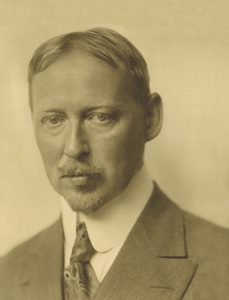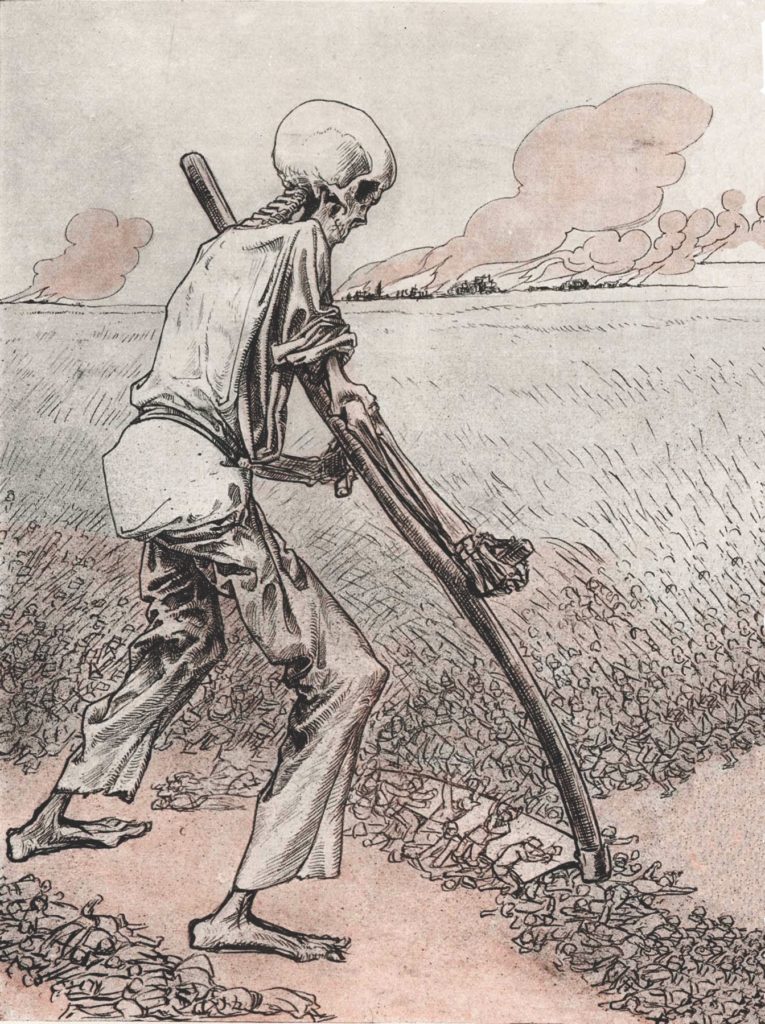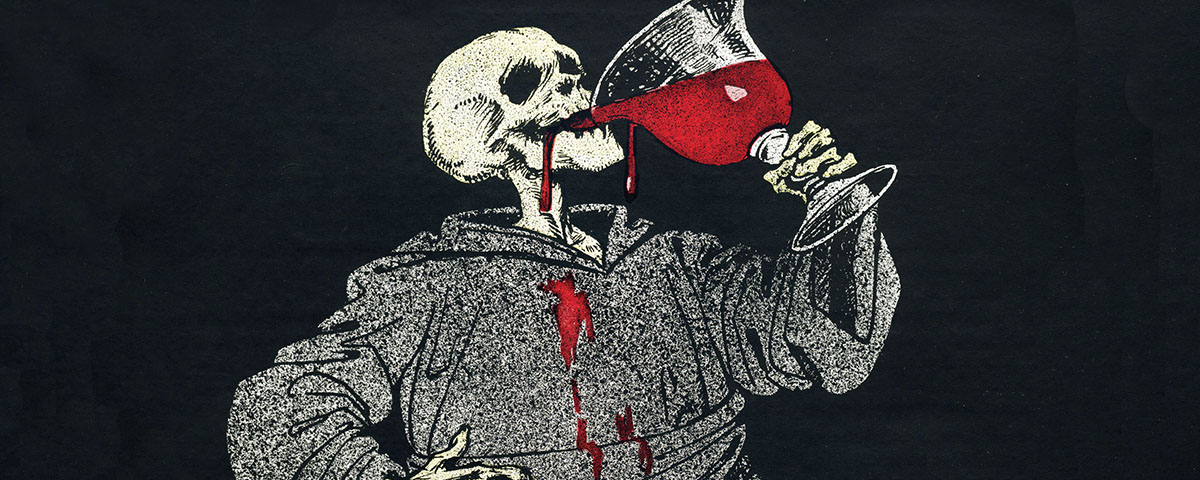Dutch cartoonist Louis Raemaekers gained international fame with his anti-German cartoons during World War I.
IN WORLD WAR I, BRITAIN TOOK THE UNPRECEDENTED STEP of enlisting artists and writers to work for its War Propaganda Bureau, informally known as Wellington House. Louis Raemaekers, a Dutch painter and political cartoonist, was one of them. Raemaekers soon began turning out some of the Allies’ most effective propaganda—not only because his cartoons packed a lot of emotional impact but also because, as a citizen of a neutral country, he was presumed an unbiased observer. In truth, however, his work was anything but neutral.

Raemaekers was born in 1869 in the Dutch town of Roermond. As a young boy, he learned basic drawing skills from his father, who published the weekly journal De Volksvriend (Friend of the People) and dabbled in watercolors. Raemaekers went on to receive formal instruction in drawing, ultimately earning a certificate from the State College for Drawing Teachers.
For several years Raemaekers worked as a drawing instructor and gave private art lessons on the side. As time allowed, he worked on his own art—painting landscapes, city scenes, and portraits and caricatures of friends and colleagues.
In 1905 Raemaekers published a series of children’s books, which he illustrated with line drawings, that told in verse the adventures of three mischievous little boys. A contemporary reviewer described them as “undoubtedly the most humorous and original picture books that have appeared for a long time.” The books, with their clever drawings and witty captions, opened doors for Raemaekers, and by the time World War I broke out in 1914, he was a full-time political cartoonist for De Telegraaf, a popular daily newspaper.
Raemaekers’ first war cartoon appeared on August 1, 1914—the day Germany declared war on Russia. In it, a young woman crouches beneath a crossed sword and scourge, her face hidden in her hands as if weeping. The caption reads, “Christendom After Twenty Centuries.” Although he wasn’t a churchgoer, Raemaekers was deeply influenced by his Catholic background and used religious, national, historical, and cultural symbolism to scathingly portray German aggression.
Raemaekers moved from restrained sorrow to biting commentary after the German army invaded neutral Belgium on August 4. As 400,000 Belgian refugees flooded into the Netherlands, bringing tales of atrocities committed by German soldiers, an incensed Raemaekers began to make drawings based on eyewitness interviews and photographs from the front. Within the first few weeks of hostilities, Raemaekers would produce some of his finest and best-known cartoons—images that would be reprinted many times in different publications and in different mediums throughout the Allied nations. In a cartoon published on August 18 and captioned “The Harvest is Ripe,” for example, Death cuts down the people of Belgium with a scythe as they attempt to defend themselves against the advancing German army. A September 20 cartoon titled “To Your Health, Civilization!” features a portly Death who quaffs from a goblet of blood as some of it slops down the front of his robe and onto the floor. In “Where are our fathers?,” published on October 8, a crowd of children, massed shoulder to shoulder, fill the space between two towering lines of crosses. They blur into a faceless, monotone crowd as they recede toward the flaming horizon, which provides the only hint of color.
While Raemaekers’s drawings were often witty, they were ultimately motivated by social compassion and focused on emotion rather than humor. Heavily influenced by Swiss artist Théophile-Alexandre Steinlen, who also used charcoal and conté crayons, Raemaekers presented the war as a battle between good and evil, between civilization and barbarism—drawn as a contrast between light and dark, large and small, weak and strong, beautiful and ugly.
Flemish writer Stijn Streuvels, who fled to the Netherlands in October 1914, described the impact of Raemaekers’s cartoons in his diary: “It is impossible to say what a tremendous impression it made on me when I first saw the prints by Ramaerkers [sic] displayed everywhere here in the windows of the bookshops. One cannot call them cartoons—they are in fact a visual summary of the tragic horror of the events of our time. I did not know that anything like that existed—it was a real revelation.”
Germany, too, recognized the raw power of Raemaekers’s cartoons. The German consul general in Amsterdam reported to Berlin: “These drawings have a particularly spiteful and poisonous impact, especially because they convey the ideas better than the written word and…also because they are by an artist of exceptional talent.” Rumors spread in the Netherlands that Germany had offered a reward of 25,000 marks for the artist’s capture.
In his cartoons Raemaekers spoke out not only against Germany’s aggression but also against Dutch neutrality, fearing that the Netherlands would share Belgium’s fate. He urged the Dutch government to take a stand on the side of Belgium and France against Germany. In this view, though, he was in the minority. Neutrality was a moral touchstone of Dutch culture, cherished at all levels of society, from Queen Wilhelmina down.
At the end of September 1914, government officials responded to a complaint that Raemaekers had violated Section 100 of the Dutch criminal code, which dealt with wartime acts that endangered the country’s neutrality. They seized the printing plate for a cartoon inspired by the destruction of the city of Reims, titled “The very stones cry out.” But the attempt to intimidate Raemaekers and De Telegraaf backfired. Newspapers in the Netherlands and abroad responded indignantly to this affront to freedom of the press.
Raemaekers’s fame soon spread to other countries. In early 1915 a postcard- size album of 24 of his cartoons was sold in Allied and neutral countries for the benefit of the French Red Cross under the title Drawings of a Neutral. A popular exhibition of his work at the Fine Arts Society in London attracted 60,000 visitors between November 1915 and January 1916. It was followed by more than 200 exhibitions around the world. An album of his drawings titled The Great War: A Neutral’s Indictment was published to acclaim in 1916. It was described in its preface as an eyewitness account with “all the authority not only of a Neutral who was unbiased but of a Neutral who knew.”
That same year Raemaekers and his family moved to London. The artist now had contracts with London’s Daily Mail, which had the largest newspaper circulation in the world, and two French newspapers, Le Journal and L’Illustration. Raemaekers became, by his own description, a one-man cartoon factory. As soon as he finished a drawing, he said, it was reproduced and distributed “all over the world…in Australia, in China, and in America—everywhere.” Working quickly in response to the news, he drew one or two cartoons a day, publishing some 1,200 over the course of the war.
With Raemaekers now in London, Britain’s War Propaganda Bureau quickly sought out his talents. The first product of their collaboration was an inexpensive album of 40 drawings intended for British soldiers on their way to the front. Wellington House also reproduced Raemaekers’s images as posters, lantern slides, and cigarette cards. The cigarette cards in particular reached an enormous audience. From 1916 to 1918 the tobacco firm Carreras Ltd. printed two series of cards using 140 of Raemaekers’s cartoons. The famous line “Lest we forget” was printed on the back. Some 50 million packages of the company’s “Black Cat” cigarettes carried the Raemaekers cards.

As Britain became increasingly desperate for the United States to enter the war, Wellington House made a clandestine attempt to distribute Raemaekers’s work in the United States, using the publishing house Land & Water as a front. Most American publications had refused to carry Raemaekers’s cartoons, fearing that by carrying anti-German material they would endanger U.S. neutrality. Unable to make much headway with the American press, Wellington House persuaded Raemaekers to go to America in person.
Editors who were hesitant or unwilling to publish Raemaekers’s cartoons were happy to report on his visit. Within a few days of his arrival in New York, most of the city’s newspapers had printed an interview with the cartoonist. The International News Service wired an article about Raemaekers to the 400 papers in its syndicate.
Perfectly open as to his reason for visiting America, Raemaekers told a reporter for the Evening Post that the United States was the country where he could make the biggest difference to the war effort. “I am working to make the greatest number of people in the world understand the struggle for liberty,” he said. “I want people to know, to think, to see the war as it is.”
After America’s entry into the war on April 6, 1917, the U.S. government followed Britain’s example and used Raemaekers’s work widely for propaganda purposes. Raemaekers, former president Theodore Roosevelt observed, “has left a record which will last for many centuries—which, mayhap, will last as long as the written record of the crimes it illustrates.”
Raemaekers, however, soon found that wartime popularity did not translate into peacetime influence. At the conclusion of the war, a weary public no longer sought depictions of violence, and interest in Raemaekers’s bloody, often brutish, drawings began to wane. He stopped drawing overtly political cartoons in 1941.
Nonetheless, when Raemaekers died on July 26, 1956, his obituary in the London Times reminded readers that the now obscure Dutch cartoonist was once one of the most influential men in the world. “He was the one private individual who exercised a real and great influence on the course of the 1914–18 War,” the newspaper noted. “There were a dozen or so people—emperors, kings, statesmen and commanders-in-chief—who obviously, and notoriously, shaped policies and guided events. Outside that circle of the great, Louis Raemaekers stands conspicuous as the one man who, without any assistance of title or office, indubitably swayed the destinies of people.” MHQ
PAMELA D. TOLER, who writes about history and the arts, is the author of Heroines of Mercy Street: The Real Nurses of the Civil War (Little, Brown and Company, 2016).
[hr]
This article appears in the Summer 2018 issue (Vol. 30, No. 4) of MHQ—The Quarterly Journal of Military History with the headline: Propaganda with a Passion
![]()





